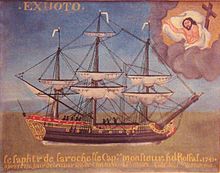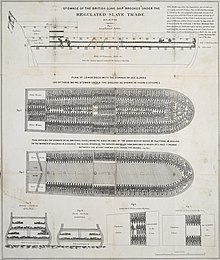Slave ship

| Part of a series on |
| Forced labour and slavery |
|---|
 |
Slave ships were large cargo ships specially converted for the purpose of transporting slaves, especially newly purchased African slaves.
The most important routes of the slave ships led from the northern and middle coasts of Africa to South America and the south coast of what is today the Caribbean and the United States of America. The captains and sailors of the boats were allowed to do whatever they wanted with the slaves. This included rape, murder, and torture because the slaves were considered their property.[citation needed] As many as 20 million Africans were transported by ship.[1] The transportation of slaves from Africa to America was known as the Middle Passage. The African slave trade was outlawed in 1807, by a law passed jointly in the United States of America and the United Kingdom, the applicable UK Act was the Abolition of the Slave Trade Act and outlawed slavery throughout the British Empire. The US law took effect on January 1, 1808. After that date all US and English slave ships leaving Africa were legally pirate vessels subject to capture by the American and British navies. In 1815, at the Council of Vienna, Spain, Portugal, France and The Netherlands also agreed to abolish their slave trade. During this time, the slave ships became smaller and more cramped in exchange for improved performance in their new role as smuggling craft and blockade runners.
Atlantic slave trade
Only a few decades after the discovery of America by Europeans, demand for cheap labor to work plantations made slave-trading a profitable business. The peak time of slave ships to the Atlantic passage was between the 17th and 18th century when large plantations developed in the English colonies of North America.
In order to achieve profit, the owners of the ships divided their hulls into holds with little headroom, so they could transport as many slaves as possible. Unhygienic conditions, dehydration, dysentery and scurvy led to a high mortality rate, on average 15%[2] and up to a third of captives. Only the most resilient survived the transport. Often the ships transported hundreds of slaves, who were chained tightly to plank beds. For example, the slave ship "Henrietta Marie" carried about 200 slaves on the long Middle Passage. They were confined to cargo holds with each slave chained with little room to move..[3]

List of slave ships
- Adelaide, French slave ship, sank 1714 near Cuba.
- Aurore, along with the Duc du Maine, the first French slave ships that brought the first slaves to Louisiana.
- La Amistad, cargo ship which sometimes carried slaves (see note below).
- Braunfisch, a Brandenburgian slave ship lost in 1688 in a revolt.
- Brookes, sailing in the 1780s.[4]
- Clotilde, burned and sunk at Mobile, in autumn 1859.
- Cora, captured by the USS Constellation in 1860.
- The Creole case was the result of a slave rebellion in 1841 on board the Creole, a ship involved in the United States coastwise slave trade.
- Desire, first American slave ship.
- Duc du Maine, along with the Aurore, the first French slave ships that brought the first slaves to Louisiana.
- Fredensborg, Danish slave ship, sank in 1768 off Tromøy in Norway, after a journey in the triangular trade. Leif Svalesen has written a book about the journey.
- Gorch Fock , a double mass ship that made multiple shipments to Florida and Louisiana.
- Henrietta Marie. Sank 1701 off Key West, Florida.
- Hope
- Jesus of Lubeck 700-tonne ship used on the second voyage of John Hawkins to transport 400 captured Africans in 1564. Queen Elizabeth I was his partner and rented him the vessel.
- Kron-Printzen, Danish slave ship, sank in 1706 with 820 slaves on board.
- Le Concord. Slave ship turned pirate ship aka Queen Anne's Revenge, Sank 1717.
- Lord Ligonier. See Roots: The Saga of an American Family by Alex Haley.
- Madre de Deus (Mother of God) 1567 John Hawkins captured this ship and transported 400 Africans.
- Margaret Scott confiscated and sunk as part of the Stone fleet in 1862
- Pons (ship) American built barque captured by the USS Yorktown 1 December 1845 with 850-900 slaves [5]
- Salamander, Brandenburgian slave ship.
- Sally, of Newport, Rhode Island - reviewed in the Report of the Brown University Steering Committee on Slavery and Justice.
- Tecora, Portuguese slave ship that transported the slaves who would later revolt aboard La Amistad.
- Triton captured by the USS Constellation 1861.
- Trouvadore, wrecked in Turks and Caicos 1841. 193 slaves survived. Project commenced in 2004 to locate the ship.[6]
- Wanderer, formerly last slave ship to the U.S. (Nov. 1858) until Clotilde reported.
- Wildfire, a barque, arrested off the Florida coast by the US Navy in 1860; carrying 450 slaves.[7]
- Whydah Gally, slave ship turned into pirate ship-sank 1717.
- Zong, a British slave ship famous of the massacre which occurred aboard in 1781.

Note: While La Amistad is often called a slave ship, it was in fact a general purpose cargo ship, which occasionally carried slaves. See the article about the ship, and the resulting court case, for more information.
See also
- Slave trade
- Slave Coast, Gorée ("Slave island")

Notes
- ^ Shillington, Kevin (2007). "Abolition and the Africa Trade". History Today. 57 (3): 20–27.
{{cite journal}}: Cite has empty unknown parameter:|coauthors=(help) - ^ Mancke, Elizabeth and Shammas, Carole. The Creation of the British Atlantic World. 2005, page 30-1
- ^ http://www.melfisher.org/exhibitions/henriettamarie/middlepassage.htm History: The Middle Passage
- ^ "Brooks Slave Ship". E. Chambre Hardman Archives. Retrieved 2008-02-28.
- ^ Gilliland, C. Herbert (2003). "Deliverance from this Floating Hell". Naval History. 17 (48–51): 20–27.
{{cite journal}}: Cite has empty unknown parameter:|coauthors=(help) - ^ Slave Ship Trouvadore Website
- ^ Harper's Weekly, June 2, 1860, p344. Online at The Slave Heritage Resource Center accessed 3 July 2006.
External links
- SlaveVoyages.org: The Trans-Atlantic Slave Trade Database
- List of slaveships
- Report of the Brown University Steering Committee on Slavery and Justice
- Unesco maps: The Slave Route (PDF)
- Scotland and the Abolition of the Slave Trade - schools resource
- Yet another article about slave ships - hundreds of German slave ships are listed in the article (PDF in German)
